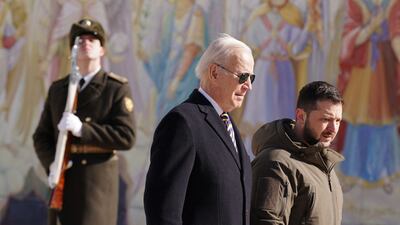Americans woke up on Monday to the news that President Joe Biden was visiting Ukraine, a risky stopover in a war zone that the White House had stressed was not going to follow his trip to neighbouring Poland.
"Are there plans for President Biden to cross into Ukraine?" White House National Security Council spokesman John Kirby was asked last Friday.
"No," Mr Kirby replied.
In fact, the unprecedented and highly secret visit had been months in the making.
Ukrainian President Volodymyr Zelenskyy had extended an open invitation to Mr Biden to visit Kyiv, as a string of western leaders including French President Emmanuel Macron, German Chancellor Olaf Scholz and Italy's then-prime minister Mario Draghi did last year.
The visit marked the first trip Mr Biden has made to a war zone since taking office two years ago.
Predecessors such as George W Bush, Barack Obama and Donald Trump all made trips to Afghanistan or Iraq, but these were to American military bases in countries with significant US presence and security.
Ukraine, by contrast, does not host US troops.
So, how did Mr Biden and the White House pull off such a visit?
After meeting his top security advisers on Friday, Mr Biden finally made the decision to proceed.
Saturday appeared to be a normal day in his schedule and on Sunday night, the White House released a statement saying Mr Biden would be in Washington until Monday evening before boarding Air Force One and heading to Warsaw.
But the President was already well on his way to Ukraine, having left earlier in the day, at 4.15am, aboard an Air Force C-32, a modified Boeing 757 normally used for domestic trips to smaller airports.
He landed in Poland on Sunday evening and then took a 10-hour overnight train to Kyiv, arriving there at 8am local time on Monday.
Shortly before Mr Biden arrived in Kyiv, the US told Moscow that he was making a surprise trip to the city to avoid any chance of conflict, a senior White House aide said.
"We did notify the Russians that President Biden will be travelling to Kyiv. We did so some hours before his departure for deconfliction purposes," said National Security Adviser Jake Sullivan.
"Because of the sensitive nature of those communications, I won't get into how they responded or what the precise nature of our message was."

"The President proceeded with the confidence that his security team was able to bring risk to a manageable level, and that was what ultimately led him to make the call to go," Mr Sullivan said.
He arrived in the Ukrainian capital at 8am local time and left about five hours later.
“It’s good to be back in Kyiv,” Mr Biden declared as he was greeted on arrival by the US ambassador, Bridget Brink.
The presidential motorcade arrived at Mariinsky Palace shortly after 8.30am local time, where he was greeted at the entrance by Mr Zelenskyy and his wife, Olena Zelenska.
“Thank you for coming," Ukraine's President said as he shook Mr Biden’s hand.
Mr Sullivan said the trip "required a security operational and logistical effort from professionals across the US government to take what was an inherently risky undertaking and make it a manageable level of risk".
"Of course, there was still risk and is still risk in an endeavour like this and President Biden felt that it was important to make this trip," he said.
Only two journalists were allowed to accompany the US President.
After handing over their devices, journalists were made aware of his presence on Air Force One just 15 minutes before the plane took off.
It was the first visit by a US president to Ukraine since 2008.













